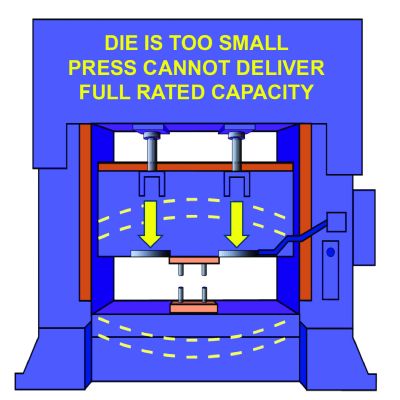Sometimes, galling can be self-inflicted when die engineers inadvertently overlook a fundamental principle in deep drawing: In-plane compression of the sheet metal causes an increase in sheet thickness.
Four Rules for Galling Reduction
1. Ensure that corner draw-forming sections have proper punch-to-die clearance for the magnitude of material thickening occurring in that portion of the die.
The arrival of CNC machining and 3D modeling has reduced the amount of time required to design, machine and assemble die components. One technique having sped up this process: the ability to cut clearance into the punch or die cavity by offsetting the cutter path by maximum material thickness. This works well until encountering a deep-drawn formed corner.
The corners in any box or irregularly shaped geometry will form in the same manner as with cylindrical cup drawing. The corners feature compressive stress on the metal moving toward the die entry and tensile stress on the metal drawn over the die radius. As a result, thickness changes that initially occurred in the flange move into the vertical wall. Consequently, the corner of the panel lacks maximum material-thickness clearance.
To reduce the likelihood of galling in draw corners, additional punch-to-die clearance must be machined in the vertical wall. To keep sheet metal flowing freely into the corner wall, the draw pad also needs additional clearance around the corners so that the thicker flange does not “pinch” the material and restrict flow. This generally requires the use of analytical tools such as metal forming simulations to achieve cost-effective results. The additional corner clearance reduces galling tendency far better—and at lower cost—than adding a surface coating. If tight corner clearance is the root cause, adding a surface treatment literally coats the problem —an expensive solution.
2. Polish all die sections for corner draws as if prepping for a surface-coating application.
Surface coatings—very expensive to apply—result in close attention paid to the heat treatment process and the quality of die polishing. Oftentimes, this level of attention greatly exceeds that given to die sections not considered for surface coating. Thus, performance improvements sometimes attributed to surface coatings may instead result from a high-quality surface-preparation process. To determine this, verify that the die component has been machined with the proper amount of clearance to accommodate thickening, and polish to a level acceptable for coating application. Next, install the die sections in the die without coating them and then document the results.
3. Address adhesive-wear problems directly.
If galling persists, increase the wear resistance of the die component and reduce the contact friction between the tooling and the workpiece. This requires proper tool-steel selection and heat treatment to ensure surface hardness that resists abrasive wear. Proper lubrication selection and application reduces contact friction.
4. Address lubrication only after complying with rules 1 through 3.
Usually, lubrication represents the first countermeasure attempted—a quick, low-cost solution—when galling persists. However, if not the root cause, lubrication proves a short-lived solution. As changes in material thickness, friction conditions, process temperature and adhesive-wear conditions vary over time, so will the effectiveness of the lubricant. The typical countermeasure: Change the lubricant concentration or change out for something “better.” Oftentimes, the problem area ends up flooded with a constant flow of lubricant, creating a housekeeping issue and increased operational costs.
Using the proper lubricant and controlling its application (volume and location) prove crucial to a successful stamping operation. However, this approach is most effective when not used to offset die-related problems.
Follow these four rules before pursuing surface treatments. Otherwise, the expensive coating may do nothing more than cover up an underlying—and perhaps less-expensive—die problem. MF
Next month: Addressing tool steel chipping and wear.
Industry-Related Terms: Abrasive,
CNC (Computer Numerical Control),
Corner,
Die,
Draw,
Drawing,
Edge,
Flange,
Form,
Forming,
Polishing,
Scrap,
Slug,
Stripping,
Surface,
ThicknessView Glossary of Metalforming Terms Technologies: Tooling









